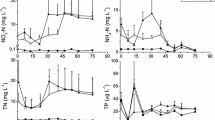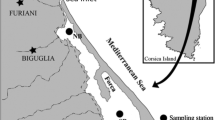Abstract
Microplankton in an oligotrophic arctic lake were assessed by direct counts for one summer prior to nutrient additions and three summers during which inorganic nitrogen and phosphorus were added to the lake at approximately ten times ambient loading rates. Protozoa increased significantly in both number and biomass following fertilization, and community structure changed from dominance by oligotrichs prior to fertilization to dominance by the bacterivorous peritrich Epistylis rotans in the second and third years of fertilization. Rotifer abundance and biomass was not significantly different among summers, although one species, Conochilus natans that had not been seen previously, was present during the second and third year of fertilization. By the third year of fertilization both protozoan and rotifer biomass had declined from peak levels, while crustacean zooplankton nauplius abundance had increased suggesting the emergence of top-down regulatory controls as the lake became eutrophic.
Similar content being viewed by others
References
Baldock, B. M., 1986. A method for enumerating protozoa in a variety of freshwater habitats. Microb. Ecol. 12: 187–191.
Berninger, U.-G., S. A. Wickham & B. J. Finlay, 1993. Trophic coupling within the microbial food web: a study with fine temporal resolution in a eutrophic freshwater ecosystem. Freshwat. Biol. 30: 419–432.
Carpenter, S. R., 1989. Replication and treatment strength in whole-lake experiments. Ecology 70: 453–463.
Carpenter, S. R., J. F. Kitchell & J. R. Hodgson, 1985. Cascading trophic interactions and lake productivity. Bioscience 35: 634–639.
Carpenter, S. R. & J. F. Kitchell, 1992. Trophic cascade and biomanipulation: Interface of research and management — a reply to the comment by DeMelo et al., Limnol. Oceanogr. 37: 208–213.
Dodson, A. & W. Thomas, 1964. Concentrating plankton in a gentle fashion. Limnol. Oceanogr. 9: 455–459.
Dumont, H. J., 1977. Biotic factors in the population dynamics of rotifers. Arch. Hydrobiol. Beih. Ergebn. Limnol. 8: 98–122.
Hanson, K. L., A. E. Hershey & M. E. McDonald, 1992. A comparison of slimy sculpin (Cottus cognatus) populations in arctic lakes with and without piscivorous predators. Hydrobiologia 240 (Dev. Hydrobiol. 78): 189–202.
Hobbie, J. E. & J. V. K. Helfrich III, 1988. The effect of grazing by microprotozoans on production of bacteria. Archiv. Hydrobiol. Beih. 31: 281–288.
Hoffman, W. & M. G. Höfle, 1993. Rotifer population dynamics in response to increased bacterial biomass and nutrients: a mesocosm experiment. Hydrobiologia 255/256 (Dev. Hydrobiol. 83): 171–175.
Kling, G. W., B. Fry & W. J. O'Brien, 1992a. Stable isotopes and planktonic trophic structure in arctic lakes. Ecology 73: 561–566.
Kling, G. W., W. J. O'Brien, M. C. Miller & A. E. Hershey, 1992b. The biogeochemistry and zoogeography of lakes and rivers in arctic Alaska. Hydrobiologia 240 (Dev. Hydrobiol. 78): 1–14.
Lee, J. J., S. H. Hunter & E. C. Bovee (eds), 1985. An illustrated guide to the protozoa. Soc. Protozool.
Miller, M. C., G. R. Hater, P. Spatt, P. Westlake & D. Yaekel, 1986. Primary production and its control in Toolik Lake, Alaska. Arch. Hydrobiol./Suppl. 74, 1: 97–131.
O'Brien, W. J., C. Buchanan & J. F. Haney, 1979. Arctic zooplankton community structure: Exceptions to some general rules. Arctic 32: 237–247.
O'Brien, W. J., A. E. Hershey, J. E. Hobbie, M. A. Huller, G. W. Kipphut, M. C. Miller, B. Moller & J. R. Vestal, 1992. Control mechanisms of arctic lake ecosystems: A limnocorral experiment. Hydrobiologia 240 (Dev. Hydrobiol. 78): 143–188.
O'Brien, W. J., M. Bahr, A. Hershey, J. Hobbie, G. Kipphut, G. Kling, H. Kling, M. McDonald, M. Miller & P. A. Rublee, 1995. The Limnology of Toolik Lake, In Milner & Oswood (eds), Alaskan Freshwaters. Springer-Verlag. In press.
Pace, M. L., 1986. An empirical analysis of zooplankton community size structure across lake trophic gradients. Limnol. Oceanogr. 31: 45–55.
Pace, M. L. & E. Funke, 1991. Regulation of planktonic microbial communities by nutrients and herbivores. Ecology 72: 904–914.
Pauli, H.-R., 1989. A new method to estimate individual dry weights of rotifers. Hydrobiologia 186/187 (Dev. Hydrobiol. 52): 355–361.
Pourriot, R., 1977. Food and feeding habits of Rotifera. Arch. Hydrobiol. Beih. Ergebn. Limnol. 8: 243–260.
Putt, M. & D. K. Stoecker, 1989. An experimentally determined carbon:volume ratio for marine ‘oligotrichous’ ciliates from estuarine and coastal waters. Limnol. Oceanogr. 34: 1097–1104.
Rieman, B. & K. Christoffersen, 1993. Microbial trophodynamics in temperate lakes. Mar. Microb. Food Webs 7: 69–100.
Rublee, P. A., 1992. Community structure and bottom-up regulation of heterotrophic microplankton in arctic LTER Lakes. Hydrobiologia 240 (Dev. Hydrobiol. 78): 133–142.
Ruttner-Kolisko, A., 1974. Plankton rotifers. Biology and taxonomy. Die Binnengewässer, Suppl. Vol. XXVI, part 1.
Ruttner-Kolisko, A. 1977. Suggestions for biomass calculation of plankton rotifers. Arch. Hydrobiol. 8: 71–76.
SAS Institute, Inc., 1988. SAS/STAT User's Guide, Release 6.03 Edition. Cary, NC.
Sanders, R. W., D. A. Caron & U.-G. Berninger, 1992. Relationships between bacteria and heterotrophic nanoplankton in marine and fresh waters: an inter-ecosystem comparison. Mar. Ecol. Progr. Series. 86: 1–14.
Schindler, D. W., 1978. Factors regulating phytoplankton production and standing crops in the world's freshwaters. Limnol. Oceanogr. 23: 478–486.
Stockner, J. G. & K. G. Porter, 1988. Microbial food webs in freshwater planktonic ecosystems. In S. R. Carpenter (ed.), Complex Interactions in lake communities. Springer-Verlag, NY: 69–83.
Author information
Authors and Affiliations
Rights and permissions
About this article
Cite this article
Rublee, P.A., Bettez, N. Change of microplankton community structure in response to fertilization of an arctic lake. Hydrobiologia 312, 183–190 (1995). https://doi.org/10.1007/BF00015511
Received:
Revised:
Accepted:
Issue Date:
DOI: https://doi.org/10.1007/BF00015511




